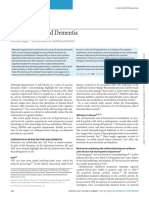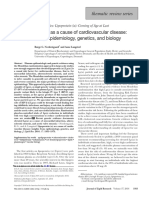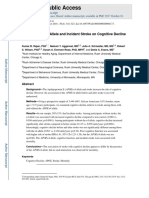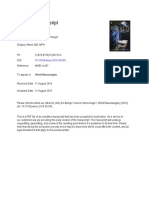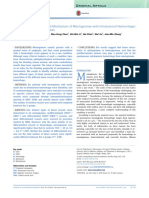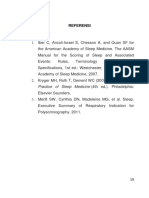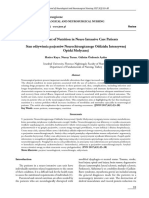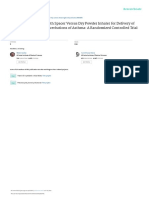Anemia and Ischemia: How Low Can You Go?: Charles T. Quinn and Michael M. Dowling
Anemia and Ischemia: How Low Can You Go?: Charles T. Quinn and Michael M. Dowling
Uploaded by
Elisabeth TikalakaCopyright:
Available Formats
Anemia and Ischemia: How Low Can You Go?: Charles T. Quinn and Michael M. Dowling
Anemia and Ischemia: How Low Can You Go?: Charles T. Quinn and Michael M. Dowling
Uploaded by
Elisabeth TikalakaOriginal Title
Copyright
Available Formats
Share this document
Did you find this document useful?
Is this content inappropriate?
Copyright:
Available Formats
Anemia and Ischemia: How Low Can You Go?: Charles T. Quinn and Michael M. Dowling
Anemia and Ischemia: How Low Can You Go?: Charles T. Quinn and Michael M. Dowling
Uploaded by
Elisabeth TikalakaCopyright:
Available Formats
From www.bloodjournal.org by guest on August 11, 2018. For personal use only.
of intraplatelet outcomes? That is the most 5. Li W, Rusiniak ME, Chintala S, Gautam R, Novak EK, 7. Stalker TJ, Welsh JD, Brass LF. Shaping the platelet
Swank RT. Murine Hermansky-Pudlak syndrome genes: response to vascular injury. Curr Opin Hematol. 2014;21(5):
fundamental question raised by both papers. regulators of lysosome-related organelles. BioEssays. 2004; 410-417.
As acknowledged by the authors, at best, an 26(6):616-628.
8. Brass LF. Thrombin and platelet activation. Chest.
incomplete answer can be given. Platelets 6. Graham GJ, Ren Q , Dilks JR, Blair P, Whiteheart SW, 2003;124(3 Suppl):18S-25S.
Flaumenhaft R. Endobrevin/VAMP-8-dependent dense
possess a number of cell-surface receptors
granule release mediates thrombus formation in vivo.
that, when activated, trigger various Blood. 2009;114(5):1083-1090. © 2015 by The American Society of Hematology
intraplatelet signaling cascades.7,8 For
example, extracellular ADP interacts with l l l RED CELLS, IRON, & ERYTHROPOIESIS
P2Y1 and P2Y2 and related receptors at the
cell surface. In turn, these receptors interact Comment on Bernaudin et al, page 1653
with G proteins and, in this case, lead to
reduced intracellular cyclic AMP levels. At
lower cyclic AMP levels, thrombin action
Anemia and ischemia:
through the PAR1 receptor leads to increased
granule secretion. However, how such a how low can you go?
-----------------------------------------------------------------------------------------------------
signaling cascade could affect the secretion
of multiple proteins from multiple granule Charles T. Quinn1 and Michael M. Dowling2 1
CINCINNATI CHILDREN’S HOSPITAL MEDICAL CENTER;
2
UNIVERSITY OF TEXAS SOUTHWESTERN MEDICAL CENTER
types is wholly unclear. We lack the
fundamental knowledge about how intraplatelet
signaling is sensed by any granule type. A In this issue of Blood, Bernaudin et al have identified the rate of acute anemic
further understanding of how platelet granule events (AAEs) and extracranial internal carotid artery (ICA) stenosis as risk
secretion may be triggered could well come factors for silent cerebral infarcts (SCIs) in children with sickle cell anemia
from understanding the full chain of events (SCA).1 SCIs refer to permanent brain lesions, usually small, that do not produce
in the 16 loci that produce HPS or related obvious focal neurologic deficits. These smaller strokes are often not “silent”
bleeding disorders. and can cause neurocognitive impairment and poor academic performance, as
In closing, these 2 papers also provide well as portend overt stroke. SCIs occur as early as the first year of life, and their
a new perspective on how platelet-plug prevalence increases with age. About 40% of adolescents with SCA have SCIs.
formation can be so localized during normal What causes this most frequent form of neurologic injury in SCA? Overt stroke in
hemostasis. Autocrine signaling through SCA is often preceded by occlusive cerebral arteriopathy of the large intracranial
release of ADP at the site of vascular damage arteries, so SCIs could be caused by an arteriopathy of small vessels, but this
is a very localized event. The concentration has not been demonstrated. Vasoocclusion of small arteries and arterioles in the
of extraplatelet ADP will only be high in the brain has also been proposed but has not been confirmed in humans. Critical
immediate area, and only proximal platelets hypoperfusion events might also cause SCIs, given that SCIs are often found in
will be affected. Blood flow will ensure watershed regions of the brain ipsilateral to occlusive cerebral arteriopathy.
that any local event is pulsatile and rapidly
dilute downstream levels of ADP. In
presenting evidence that the dense granule I dentifying the risk factors for SCIs can
help reveal their cause. Recently, several
groups have identified a clear association
patients who had “acute SCI” or acute silent
cerebral ischemic events (ASCIEs) during
complications of SCA, 4 of which were AAEs.5
is the source autocrine signal, these authors
may have opened a novel perspective to between SCIs and degree of baseline anemia. A prospective study showed that ASCIEs
understanding hemostasis in a more general A US group showed that lower rates of occurred in nearly 20% of children with
sense. pain and acute chest syndrome, lower SCA hospitalized for AAEs, defined as a Hb
Conflict-of-interest disclosure: The author baseline hemoglobin (Hb) concentration, and level of ,5.5 g/dL and 30% or more lower
declares no competing financial interests. n intracranial arterial stenosis were risk factors than baseline.6 A multicenter study showed
for SCIs.2 A group in France found that lower that ASCIEs could also be detected
REFERENCES baseline Hb concentration was the only in asymptomatic, clinically well children
1. Meng R, Wu J, Harper DC, et al. Defective release independent predictor of SCIs.3 Most recently, undergoing screening magnetic resonance
of a granule and lysosome contents from platelets in an international study group identified lower imaging of the brain.7 Compared with the
mouse Hermansky-Pudlak syndrome models. Blood.
2015;125(10):1623-1632. baseline Hb concentration, higher baseline baseline rate of initial SCIs, the rate of
2. Sharda A, Kim SH, Jasuja R, et al. Defective PDI systolic blood pressure, and male sex as risk ASCIEs was 40-fold higher in children who
release from platelets and endothelial cells impairs factors.4 So, degree of baseline anemia does already had a “remote” SCI, whereas AAE
thrombus formation in Hermansky-Pudlak syndrome.
Blood. 2015;125(10):1633-1642. appear to be important in the genesis of SCIs, increased the incidence of ASCIEs 600-fold.6-8
3. Nurden AT, Freson K, Seligsohn U. Inherited but we also need to know when SCIs occur Some ASCIEs appear to be reversible and
platelet disorders. Haemophilia. 2012;18(Suppl 4): to understand their causes better. leave no detectable lesion, whereas others
154-160.
Three reports have shown that SCIs are become permanent SCIs.
4. Marks MS, Heijnen HFG, Raposo G. Lysosome-
related organelles: unusual compartments become detectable during the acutely ischemic phase Bernaudin et al hypothesized that
mainstream. Curr Opin Cell Biol. 2013;25(4):495-505. (see figure). The first was a case series of 7 common clinical complications associated
1516 BLOOD, 5 MARCH 2015 x VOLUME 125, NUMBER 10
From www.bloodjournal.org by guest on August 11, 2018. For personal use only.
cerebral ischemia.10 In addition to dilution
of sickle Hb, chronic transfusions might
prevent SCIs because chronic anemia is
decreased, and a higher baseline Hb
concentration can mitigate the severity of
AAEs. Given the association of AAEs with
cerebral ischemia, we may need to be more
liberal in our transfusion practices for acute
complications of SCA. Transfusion to correct
at least the acute component of anemia might
be neuroprotective during AAEs, especially
because some ASCIEs appear to be reversible.
Many patients with SCA tolerate mild to
moderate exacerbations of anemia reasonably
well, but this perception primarily is based on
cardiopulmonary signs and symptoms, which
is how we traditionally define “symptomatic
anemia.” But ASCIEs and SCIs are “silent”
Anemia and cerebral ischemia. Shown here is magnetic resonance imaging of the brain during (A) and 7 months after
by definition, so how low can you (safely) go?
(B) an acute anemic event in a patient with sickle cell anemia who had no focal neurologic signs corresponding to the
brain lesion. A focus of restricted diffusion on diffusion-weighted imaging (A) indicates this is an acutely ischemic lesion. The answer is not entirely clear, but waiting
(B) Typical, T2-hyperintense, permanent silent cerebral infarct corresponding to the focus of the acute ischemia for the appearance of “symptomatic anemia”
detected during the acute anemic event. The imaging was obtained for a screening clinical research study, not for
clinical suspicion of stroke. may be too late for the brain. n
REFERENCES
with hypoperfusion and hypoxemia, such as cerebral oxygen extraction, and possibly 1. Bernaudin F, Verlhac S, Arnaud C, et al. Chronic and
AAEs and acute chest syndrome, as well as increased cerebral metabolic rate in SCA. acute anemia and extracranial internal carotid stenosis are
extracranial ICA stenosis, were associated ASCIEs that occur during the baseline state risk factors for silent cerebral infarcts in sickle cell anemia.
Blood. 2015;125(10):1653-1661.
with SCIs.1 Recall, the risk for overt stroke is probably reflect ongoing ischemic injury
2. Kwiatkowski JL, Zimmerman RA, Pollock AN, et al.
routinely assessed in SCA by ultrasonography resulting from chronic anemia and arterial Silent infarcts in young children with sickle cell disease.
of intracranial arteries. The study population stenosis. Such ASCIEs are often small and Br J Haematol. 2009;146(3):300-305.
was a contemporary (1992-2010) and potentially reversible, but some do progress to 3. Bernaudin F, Verlhac S, Arnaud C, et al. Impact of
early transcranial Doppler screening and intensive therapy
aggressively treated cohort of children with SCIs. AAEs amplify this pathology and on cerebral vasculopathy outcome in a newborn sickle cell
SCA followed longitudinally by magnetic dramatically increase the incidence of anemia cohort. Blood. 2011;117(4):1130-1140.
resonance imaging and angiography. None ASCIEs6 (the acute lesion) and SCIs (the 4. DeBaun MR, Sarnaik SA, Rodeghier MJ, et al.
had overt stroke. The study confirmed that remote lesion).1 Certainly other factors are Associated risk factors for silent cerebral infarcts in sickle
cell anemia: low baseline hemoglobin, sex, and relative
degree of baseline anemia, defined here as involved, such as sickling and vasoocclusion high systolic blood pressure. Blood. 2012;119(16):
a Hb concentration lower than 7g/dL before resulting from Hb desaturation. However, 3684-3690.
age 3 years, was a risk factor for SCIs. ASCIEs also occur in children with AAEs 5. Dowling MM, Quinn CT, Rogers ZR, Buchanan GR.
Acute silent cerebral infarction in children with sickle cell
Moreover, the yearly rate of AAEs experienced who do not have SCA, so sickle Hb is
anemia. Pediatr Blood Cancer. 2010;54(3):461-464.
by the patient, or the frequency of acute not necessarily required for their formation.6
6. Dowling MM, Quinn CT, Plumb P, et al. Acute silent
exacerbations of chronic anemia, and isolated Moreover, similar brain lesions occur in very cerebral ischemia and infarction during acute anemia in
extracranial ICA stenosis were identified as well-transfused patients with thalassemia,9 so children with and without sickle cell disease. Blood. 2012;
120(19):3891-3897.
novel risk factors for SCIs, but not rate of perhaps platelet activation and prothrombotic
7. Quinn CT, McKinstry RC, Dowling MM, et al. Acute
pain or acute chest syndrome. potential play additional roles that may be silent cerebral ischemic events in children with sickle cell
The degree of chronic anemia and more important in thalassemia than SCA. anemia. JAMA Neurol. 2013;70(1):58-65.
the occurrence and frequency of AAEs, How does the clear association of SCIs 8. Pegelow CH, Macklin EA, Moser FG, et al.
therefore, are important risk factors for with acute and chronic anemia inform the Longitudinal changes in brain magnetic resonance imaging
findings in children with sickle cell disease. Blood. 2002;
SCIs. Also, considering their association care of patients with SCA? Although there 99(8):3014-3018.
with arterial stenosis, SCIs are likely the are no randomized trials to show that 9. Musallam KM, Taher AT, Karimi M, Rachmilewitz
consequence of impaired oxygen delivery hydroxyurea decreases the incidence of SCIs, EA. Cerebral infarction in b-thalassemia intermedia:
breaking the silence. Thromb Res. 2012;130(5):695-702.
to the brain resulting from the combined widespread use of this prophylactic therapy
10. DeBaun MR, Gordon M, McKinstry RC, et al.
limitation of blood flow (stenosis) and to decrease the degree of chronic anemia Controlled trial of transfusions for silent cerebral infarcts
oxygen-carrying capacity (anemia). This is reasonable (among other benefits). For in sickle cell anemia. N Engl J Med. 2014;371(8):699-710.
is compounded by the impairment of patients who already have SCIs, chronic
cerebrovascular autoregulation, near-maximal transfusion therapy decreases recurrent © 2015 by The American Society of Hematology
BLOOD, 5 MARCH 2015 x VOLUME 125, NUMBER 10 1517
From www.bloodjournal.org by guest on August 11, 2018. For personal use only.
2015 125: 1516-1517
doi:10.1182/blood-2015-01-619981
Anemia and ischemia: how low can you go?
Charles T. Quinn and Michael M. Dowling
Updated information and services can be found at:
http://www.bloodjournal.org/content/125/10/1516.full.html
Articles on similar topics can be found in the following Blood collections
Free Research Articles (5107 articles)
Information about reproducing this article in parts or in its entirety may be found online at:
http://www.bloodjournal.org/site/misc/rights.xhtml#repub_requests
Information about ordering reprints may be found online at:
http://www.bloodjournal.org/site/misc/rights.xhtml#reprints
Information about subscriptions and ASH membership may be found online at:
http://www.bloodjournal.org/site/subscriptions/index.xhtml
Blood (print ISSN 0006-4971, online ISSN 1528-0020), is published weekly by the American Society
of Hematology, 2021 L St, NW, Suite 900, Washington DC 20036.
Copyright 2011 by The American Society of Hematology; all rights reserved.
You might also like
- SDRRMC Action Plan 2020-2021 Erika WayawayDocument6 pagesSDRRMC Action Plan 2020-2021 Erika WayawayErika Wayaway100% (12)
- Body For Life Seminar GuideDocument15 pagesBody For Life Seminar GuideAbhimanyu SinghNo ratings yet
- HomelessnessDocument24 pagesHomelessnessGeorge Ataher100% (4)
- Genomics and Cardiac Arrhythmias: Cardiovascular Genomic MedicineDocument13 pagesGenomics and Cardiac Arrhythmias: Cardiovascular Genomic MedicineKishore ChinnaNo ratings yet
- Distinct HLA Associations by Stroke Subtype in Children With Sickle Cell AnemiaDocument5 pagesDistinct HLA Associations by Stroke Subtype in Children With Sickle Cell AnemiaLarissa Rodrigues MichalskyNo ratings yet
- jama_prabhakaran_2022_ed_220009_1647557363.70782Document2 pagesjama_prabhakaran_2022_ed_220009_1647557363.70782Aling AyenNo ratings yet
- Cerebralamyloid Angiopathy: Laszlo Szidonya,, Joshua P. NickersonDocument12 pagesCerebralamyloid Angiopathy: Laszlo Szidonya,, Joshua P. NickersonJuan Carlos LazoNo ratings yet
- Treatment For Aplastic AnemiaDocument13 pagesTreatment For Aplastic Anemiagustianto hutama pNo ratings yet
- Pathogenesis of Hepatic Encephalopathy in Acute Liver Failure 2003Document12 pagesPathogenesis of Hepatic Encephalopathy in Acute Liver Failure 2003MarleyNo ratings yet
- (10920684 - Neurosurgical Focus) Cerebral Amyloid Angiopathy-Associated Intracerebral Hemorrhage - Pathology and ManagementDocument14 pages(10920684 - Neurosurgical Focus) Cerebral Amyloid Angiopathy-Associated Intracerebral Hemorrhage - Pathology and Managementkung_pauNo ratings yet
- Anemia in Heart Failure-A Concise ReviewDocument5 pagesAnemia in Heart Failure-A Concise Reviewvikram.vNo ratings yet
- Hypertension and DementiaDocument9 pagesHypertension and DementiaJenny LeeNo ratings yet
- Cerebral Blood Flow in Alzheimer s DiseaseDocument14 pagesCerebral Blood Flow in Alzheimer s Diseasesdsaptarshidas18No ratings yet
- Scans en 2015Document43 pagesScans en 2015Carolina Duque RodriguezNo ratings yet
- JAH3-12-e029100Document16 pagesJAH3-12-e029100Raluca HagăuNo ratings yet
- Riñon y Insufi CardDocument5 pagesRiñon y Insufi CardCardiaca InsuficienciaNo ratings yet
- Left Atrial Enlargement and Stroke Recurrence The NorthernDocument14 pagesLeft Atrial Enlargement and Stroke Recurrence The NorthernThais ReisNo ratings yet
- FULLTEXT02Document12 pagesFULLTEXT02Levi SousaNo ratings yet
- Emcefalopatias Vasculares en CaninosDocument14 pagesEmcefalopatias Vasculares en CaninosStefanySalasNo ratings yet
- Heart review Accepted versionDocument31 pagesHeart review Accepted versioncharmantmayuwano4No ratings yet
- Referensi Tesis 1Document6 pagesReferensi Tesis 1Endy SusenoNo ratings yet
- Levitt2019 PDFDocument14 pagesLevitt2019 PDFalejandro echeverriNo ratings yet
- 72.full PDFDocument11 pages72.full PDFnisrina17No ratings yet
- Anemia and Congestive Heart Failure: Wolfram Steinborn Piotr Ponikowski, MD, PHD, Fesc Stefan Anker, MD, PHDDocument2 pagesAnemia and Congestive Heart Failure: Wolfram Steinborn Piotr Ponikowski, MD, PHD, Fesc Stefan Anker, MD, PHDvani marindaniNo ratings yet
- Population-Based Analysis of Sudden Cardiac Death With and Without Left Ventricular Systolic DysfunctionDocument6 pagesPopulation-Based Analysis of Sudden Cardiac Death With and Without Left Ventricular Systolic DysfunctionPA7 - EXAMNo ratings yet
- Dyspnea: How To Differentiate Between Acute Heart Failure Syndrome and Other DiseasesDocument2 pagesDyspnea: How To Differentiate Between Acute Heart Failure Syndrome and Other DiseasesAyaNo ratings yet
- Lipoprotein A As A Cause of Cardiovascular Disease Ins - 2016 - Journal of Li PDFDocument23 pagesLipoprotein A As A Cause of Cardiovascular Disease Ins - 2016 - Journal of Li PDFChrispinus LinggaNo ratings yet
- Simon 2016Document12 pagesSimon 2016yoNo ratings yet
- Cerebral Perfusion in Sepsis-Associated Delirium: ResearchDocument9 pagesCerebral Perfusion in Sepsis-Associated Delirium: ResearchPedro VillalobosNo ratings yet
- Rojanasopondist Et Al 2022 Genetic Basis of Left Ventricular NoncompactionDocument11 pagesRojanasopondist Et Al 2022 Genetic Basis of Left Ventricular NoncompactionbalounovaNo ratings yet
- 12-Year Follow-Up Study - Total Cerebral Blood Flow and Mortality in Old AgeDocument8 pages12-Year Follow-Up Study - Total Cerebral Blood Flow and Mortality in Old AgeJ ChenNo ratings yet
- Case ReportDocument6 pagesCase ReportSamanthaNo ratings yet
- Nihms 237406Document9 pagesNihms 237406Antonio GligorievskiNo ratings yet
- Abstracts / Atherosclerosis 252 (2016) E1 Ee196 E185Document2 pagesAbstracts / Atherosclerosis 252 (2016) E1 Ee196 E185MaulNo ratings yet
- RG 265055090Document16 pagesRG 265055090MAPACHE 91No ratings yet
- The Global Burden of Aortic StenosisDocument7 pagesThe Global Burden of Aortic Stenosisdikke.koe696No ratings yet
- Diagnostic Challenges in RCVS, PACNS, and Other Cerebral ArteriopathiesDocument4 pagesDiagnostic Challenges in RCVS, PACNS, and Other Cerebral ArteriopathiesSylvain DesforgesNo ratings yet
- 426 - Pathobiology of Intracranial AneurysmsDocument17 pages426 - Pathobiology of Intracranial AneurysmsharshpratapsinghirNo ratings yet
- Stroke Prevention and Treatment in Sickle Cell Disease: Robert J. Adams, MS, MDDocument4 pagesStroke Prevention and Treatment in Sickle Cell Disease: Robert J. Adams, MS, MDMeshaki MbarukaNo ratings yet
- Cerebral Amyloid Angiopathy-Medscape (2023 - 10 - 28)Document11 pagesCerebral Amyloid Angiopathy-Medscape (2023 - 10 - 28)Apostolos T.No ratings yet
- Caso Anemia 5Document3 pagesCaso Anemia 5Caramelitos De DiversionNo ratings yet
- Comment: Vs 1 7% of 261 Patients With Atrial TachyarrhythmiasDocument2 pagesComment: Vs 1 7% of 261 Patients With Atrial TachyarrhythmiasDewina Dyani Rosari IINo ratings yet
- Anemia de Cells Falc en Urgencias Clínicas NADocument19 pagesAnemia de Cells Falc en Urgencias Clínicas NACarlos Andres Barrera ParraNo ratings yet
- Foley 2016Document7 pagesFoley 2016toltahespeNo ratings yet
- A 19-Year-Old Man With Sickle Cell Disease Presenting With Spinal Infarction: A Case ReportDocument6 pagesA 19-Year-Old Man With Sickle Cell Disease Presenting With Spinal Infarction: A Case ReportJabber PaudacNo ratings yet
- Angiopathy StrokeDocument7 pagesAngiopathy Strokearia tristayanthiNo ratings yet
- Hemoptisis 4Document6 pagesHemoptisis 4habiba rositaNo ratings yet
- Duct Dependent Heart Lesions by DR Parashuram Waddar (Pediatrician, MBBS, DCH DNB)Document63 pagesDuct Dependent Heart Lesions by DR Parashuram Waddar (Pediatrician, MBBS, DCH DNB)parasuram waddarNo ratings yet
- Platelet C4d Is Highly Specific For Systemic Lupus ErythematosusDocument5 pagesPlatelet C4d Is Highly Specific For Systemic Lupus ErythematosusAlisNo ratings yet
- Optimal PH Strategy For Hypothermic Circulatory Ar PDFDocument2 pagesOptimal PH Strategy For Hypothermic Circulatory Ar PDFKhairunnisa FitriNo ratings yet
- Management of Aneurysmal SAHDocument24 pagesManagement of Aneurysmal SAHanastassiya.kozlovskayaNo ratings yet
- Molecular Investigation Into The Human Atrioventricular Node in Heart Failure 2161 0940.1000164Document8 pagesMolecular Investigation Into The Human Atrioventricular Node in Heart Failure 2161 0940.1000164Mei RieģoNo ratings yet
- Milno Et AlDocument9 pagesMilno Et AlLara SilveiraNo ratings yet
- AcuapurinasDocument7 pagesAcuapurinasLenner Urtecho CalderonNo ratings yet
- Hofmann Et AlDocument10 pagesHofmann Et Alsulabha0987No ratings yet
- Charlton 2006Document6 pagesCharlton 2006Cyberterton4No ratings yet
- Genetic, Laboratory and Clinical Risk Factors in TheDocument16 pagesGenetic, Laboratory and Clinical Risk Factors in ThearturomarticarvajalNo ratings yet
- Rossano2014 PDFDocument6 pagesRossano2014 PDFAditya SanjayaNo ratings yet
- 1 s2.0 S0735109716332739 MainDocument11 pages1 s2.0 S0735109716332739 MainBhagya Narayan PanditNo ratings yet
- How I Manage Cerebral Vasculopathy in Children With Sickle Cell Anemia BJH 2015Document11 pagesHow I Manage Cerebral Vasculopathy in Children With Sickle Cell Anemia BJH 2015amara.ablaNo ratings yet
- Vasospasm After Aneurysmal Subarachnoid Hemorrhage: NeurologyDocument8 pagesVasospasm After Aneurysmal Subarachnoid Hemorrhage: NeurologyGary MiguelNo ratings yet
- Subhyaloid Hemorrhage in Cerebral Malaria: Case ReportDocument4 pagesSubhyaloid Hemorrhage in Cerebral Malaria: Case ReportFaza KahfiNo ratings yet
- Developmental Delay: Identification and Management at Primary Care LevelDocument5 pagesDevelopmental Delay: Identification and Management at Primary Care LevelElisabeth TikalakaNo ratings yet
- HHS Public Access: Role of APOE 4 Allele and Incident Stroke On Cognitive Decline and MortalityDocument15 pagesHHS Public Access: Role of APOE 4 Allele and Incident Stroke On Cognitive Decline and MortalityElisabeth TikalakaNo ratings yet
- Relationship Between Oral Microbiota and Periodontal Disease: A Systematic ReviewDocument14 pagesRelationship Between Oral Microbiota and Periodontal Disease: A Systematic ReviewElisabeth TikalakaNo ratings yet
- Cureus 0010 00000002031Document5 pagesCureus 0010 00000002031Elisabeth TikalakaNo ratings yet
- 2017 07 Diabetes Shift Oral Microbiome FostersDocument3 pages2017 07 Diabetes Shift Oral Microbiome FostersElisabeth TikalakaNo ratings yet
- Magnetic Resonance Imaging of MeningiomasDocument9 pagesMagnetic Resonance Imaging of MeningiomasElisabeth TikalakaNo ratings yet
- Bells PalsyDocument6 pagesBells PalsyElisabeth TikalakaNo ratings yet
- Vij 2012Document4 pagesVij 2012Elisabeth TikalakaNo ratings yet
- Accepted Manuscript: 10.1016/j.wneu.2016.08.056Document6 pagesAccepted Manuscript: 10.1016/j.wneu.2016.08.056Elisabeth TikalakaNo ratings yet
- Tolosa-Hunt Syndrome in Double-Hit Lymphoma: Case Reports in Oncological Medicine March 2015Document6 pagesTolosa-Hunt Syndrome in Double-Hit Lymphoma: Case Reports in Oncological Medicine March 2015Elisabeth TikalakaNo ratings yet
- Defining The Gut Microbiota in Individuals With Periodontal Diseases: An Exploratory StudyDocument13 pagesDefining The Gut Microbiota in Individuals With Periodontal Diseases: An Exploratory StudyElisabeth TikalakaNo ratings yet
- Wang 2016Document9 pagesWang 2016Elisabeth TikalakaNo ratings yet
- Increased Levels of Porphyromonas Gingivalis Are Associated With Ischemic and Hemorrhagic Cerebrovascular Disease in Humans: An in Vivo StudyDocument9 pagesIncreased Levels of Porphyromonas Gingivalis Are Associated With Ischemic and Hemorrhagic Cerebrovascular Disease in Humans: An in Vivo StudyElisabeth TikalakaNo ratings yet
- Tolosa-Hunt Syndrome: A Rare Cause For An Isolated Ocular Nerve Palsy in An Elderly MaleDocument3 pagesTolosa-Hunt Syndrome: A Rare Cause For An Isolated Ocular Nerve Palsy in An Elderly MaleElisabeth TikalakaNo ratings yet
- The Relationship Between Parkinson Disease and Brain Tumor: A Meta-AnalysisDocument12 pagesThe Relationship Between Parkinson Disease and Brain Tumor: A Meta-AnalysisElisabeth TikalakaNo ratings yet
- Referensi: Practice of Sleep Medicine (4th Ed.) - PhiladelphiaDocument1 pageReferensi: Practice of Sleep Medicine (4th Ed.) - PhiladelphiaElisabeth TikalakaNo ratings yet
- Macrophage Activation and Its Role in Repair and Pathology After Spinal Cord InjuryDocument11 pagesMacrophage Activation and Its Role in Repair and Pathology After Spinal Cord InjuryElisabeth TikalakaNo ratings yet
- An Update in Guillain-Barré Syndrome: January 2014Document7 pagesAn Update in Guillain-Barré Syndrome: January 2014Elisabeth TikalakaNo ratings yet
- Frequencies Frequency TableDocument18 pagesFrequencies Frequency TableElisabeth TikalakaNo ratings yet
- Management of Nutrition in Neuro Intensive Care Patients Stan Odżywienia Pacjentów Neurochirurgicznego Oddziału Intensywnej Opieki MedycznejDocument6 pagesManagement of Nutrition in Neuro Intensive Care Patients Stan Odżywienia Pacjentów Neurochirurgicznego Oddziału Intensywnej Opieki MedycznejElisabeth TikalakaNo ratings yet
- Guillain Barré Syndrome: J B WinerDocument5 pagesGuillain Barré Syndrome: J B WinerElisabeth TikalakaNo ratings yet
- Organon Homoeopathy HistoryDocument1 pageOrganon Homoeopathy HistoryAnjum AbbasiNo ratings yet
- HSSC Admission Form 2019Document2 pagesHSSC Admission Form 2019mohammad hamzaNo ratings yet
- Field Guide Re Conduct of Cso Conference: From Few To Many For Greater ImpactDocument24 pagesField Guide Re Conduct of Cso Conference: From Few To Many For Greater Impactkeith tanuecoNo ratings yet
- Metered Dose Inhaler With Spacer Versus Dry Powder Inhaler For Delivery of Salbutamol in Acute Exacerbations of Asthma: A Randomized Controlled TrialDocument7 pagesMetered Dose Inhaler With Spacer Versus Dry Powder Inhaler For Delivery of Salbutamol in Acute Exacerbations of Asthma: A Randomized Controlled TrialYan Hein TanawaniNo ratings yet
- Rubrics Perilight TherapyDocument1 pageRubrics Perilight TherapyPrinces Vench SanchezNo ratings yet
- Amravati Smartcity PlanDocument29 pagesAmravati Smartcity PlanSam BNo ratings yet
- Wound Irrigation 21.Document18 pagesWound Irrigation 21.Juice Wrld 999No ratings yet
- Should Physicians Participate in ExecutionsDocument4 pagesShould Physicians Participate in Executionsapi-285851435No ratings yet
- Covid Patient DetailsDocument7 pagesCovid Patient DetailsSr. Section Engineer Coaching Depot-ValsadNo ratings yet
- MarriageDocument38 pagesMarriagedrkadiyala2No ratings yet
- VA30Document2 pagesVA30Hoang TanNo ratings yet
- 100k Training Plan Compete KMDocument1 page100k Training Plan Compete KMPhan ToanNo ratings yet
- Maternity Benefit Act, 1961Document15 pagesMaternity Benefit Act, 1961Jyoti DaveNo ratings yet
- Biuret Reagent (Mixture) SDSDocument4 pagesBiuret Reagent (Mixture) SDSshennoNo ratings yet
- Carcass and Performance Characteristics of Broiler Chickens Fed With Cymbopogon Citratus Leaf Meal As Alternative To Mycotoxin BinderDocument6 pagesCarcass and Performance Characteristics of Broiler Chickens Fed With Cymbopogon Citratus Leaf Meal As Alternative To Mycotoxin BinderEduard MorenoNo ratings yet
- AIIMSDocument9 pagesAIIMSSandesh PandeyNo ratings yet
- Psychopathology of Alcohol-Induced Psychosis: EtiologyDocument3 pagesPsychopathology of Alcohol-Induced Psychosis: EtiologySharlaine CabanayanNo ratings yet
- Patient ManagementDocument101 pagesPatient ManagementRhutvi ViraniNo ratings yet
- 02.worksheet-2 U1Document1 page02.worksheet-2 U1Jose Manuel AlcantaraNo ratings yet
- Hemoflagellates - Lecture Notes For Clinical Parasitology Hemoflagellates - Lecture Notes For Clinical ParasitologyDocument6 pagesHemoflagellates - Lecture Notes For Clinical Parasitology Hemoflagellates - Lecture Notes For Clinical ParasitologypearlsNo ratings yet
- PericarditisDocument14 pagesPericarditisshizarahimNo ratings yet
- Fukushima's Dark Secret - Keshe TechDocument4 pagesFukushima's Dark Secret - Keshe Techeuripides77No ratings yet
- 8ab Quick CheckDocument1 page8ab Quick CheckatmycraftiwillbecomethegreatesNo ratings yet
- Cerebrospinal Fluid (CSF) AnalysisDocument8 pagesCerebrospinal Fluid (CSF) AnalysisVidhya.MNo ratings yet
- WVSU College of Medicine Full Website InfoDocument11 pagesWVSU College of Medicine Full Website InfoMiguel MansillaNo ratings yet
- Final 1ST Semester 2024-2025 Examination TimetableDocument78 pagesFinal 1ST Semester 2024-2025 Examination Timetablesharonmwikali718No ratings yet
- Oltmanns - Restrictions in The Use of Biocides For Disinfection ProceduresDocument25 pagesOltmanns - Restrictions in The Use of Biocides For Disinfection ProceduresDiptarghya KunduNo ratings yet











